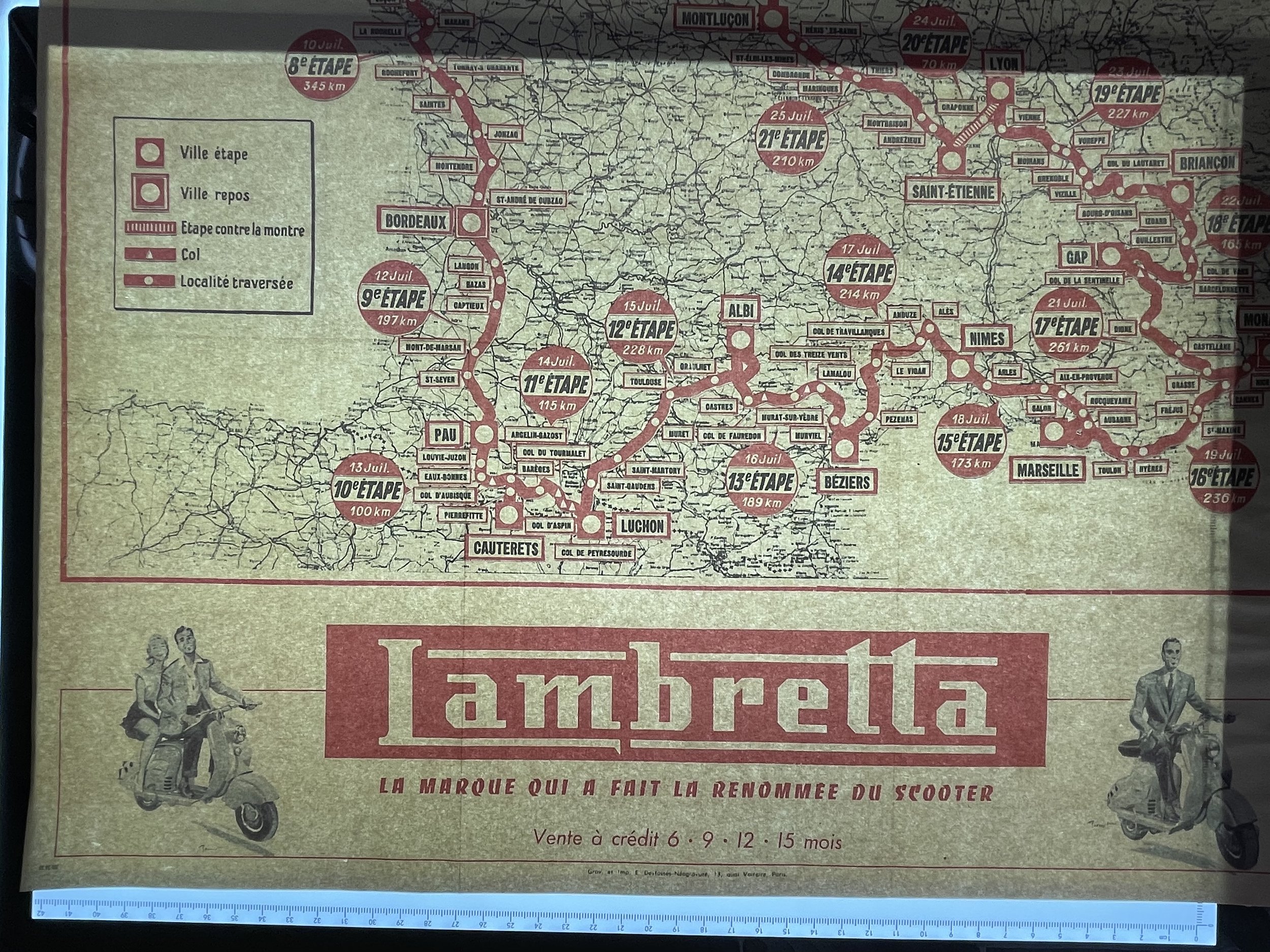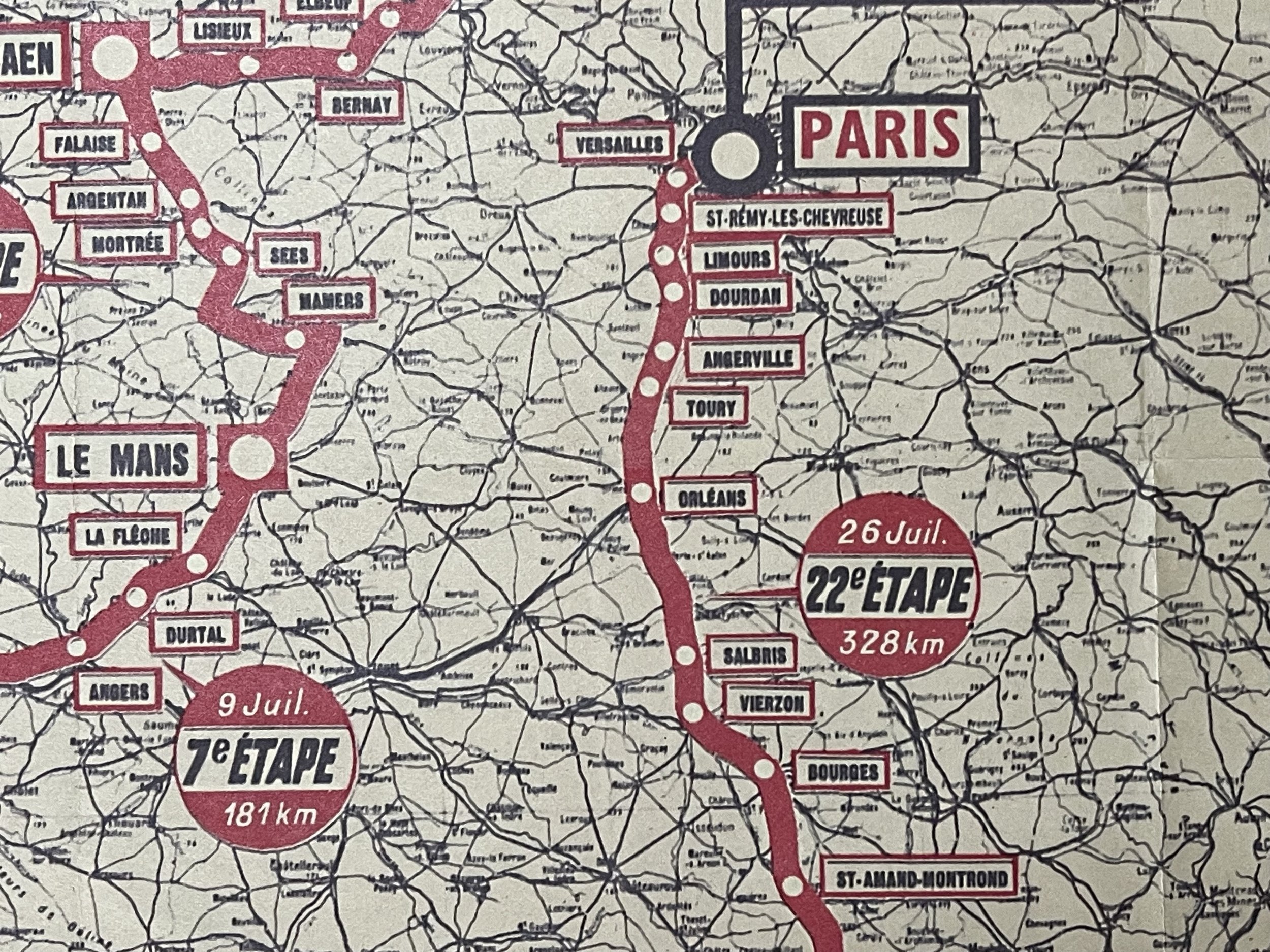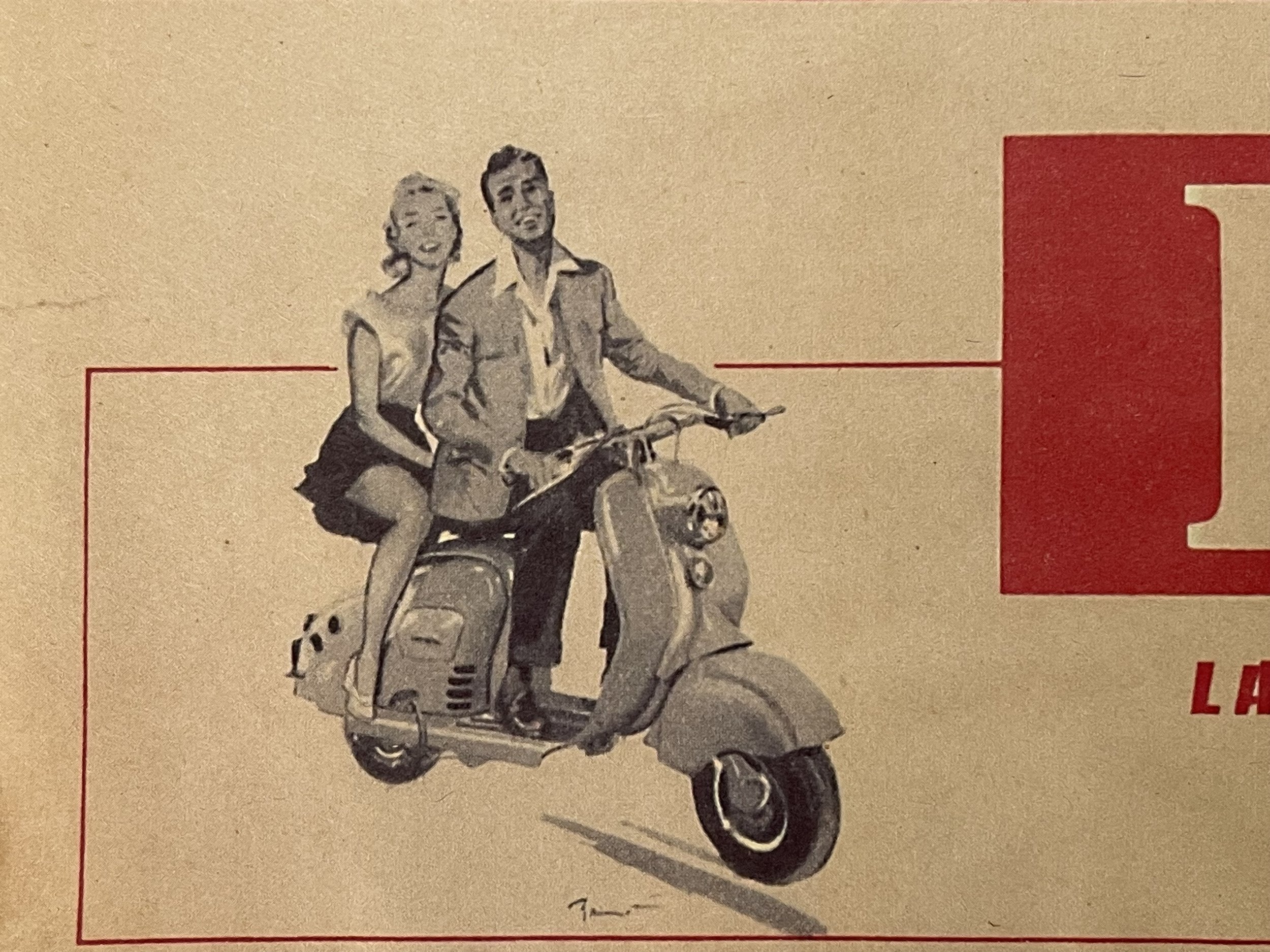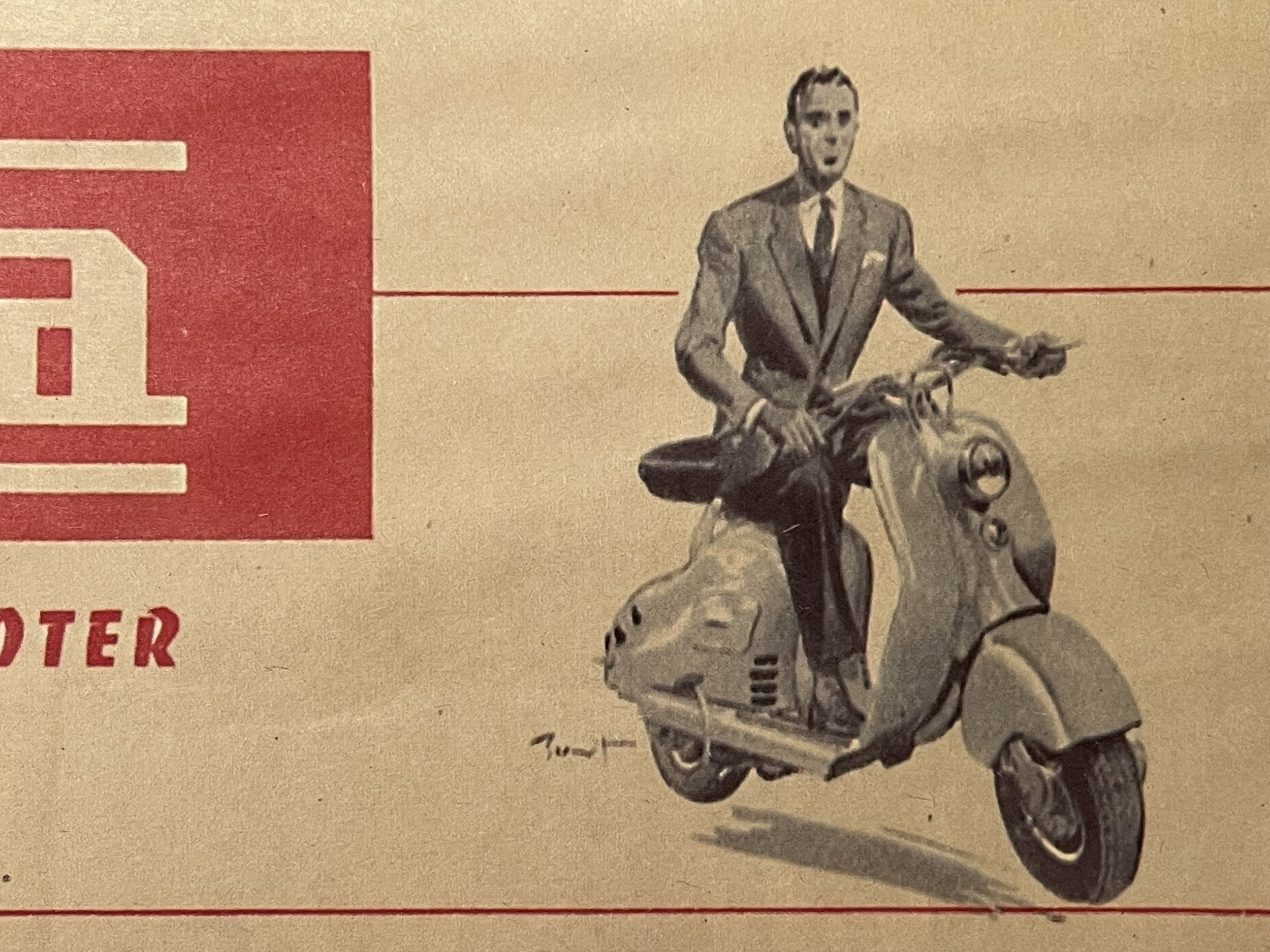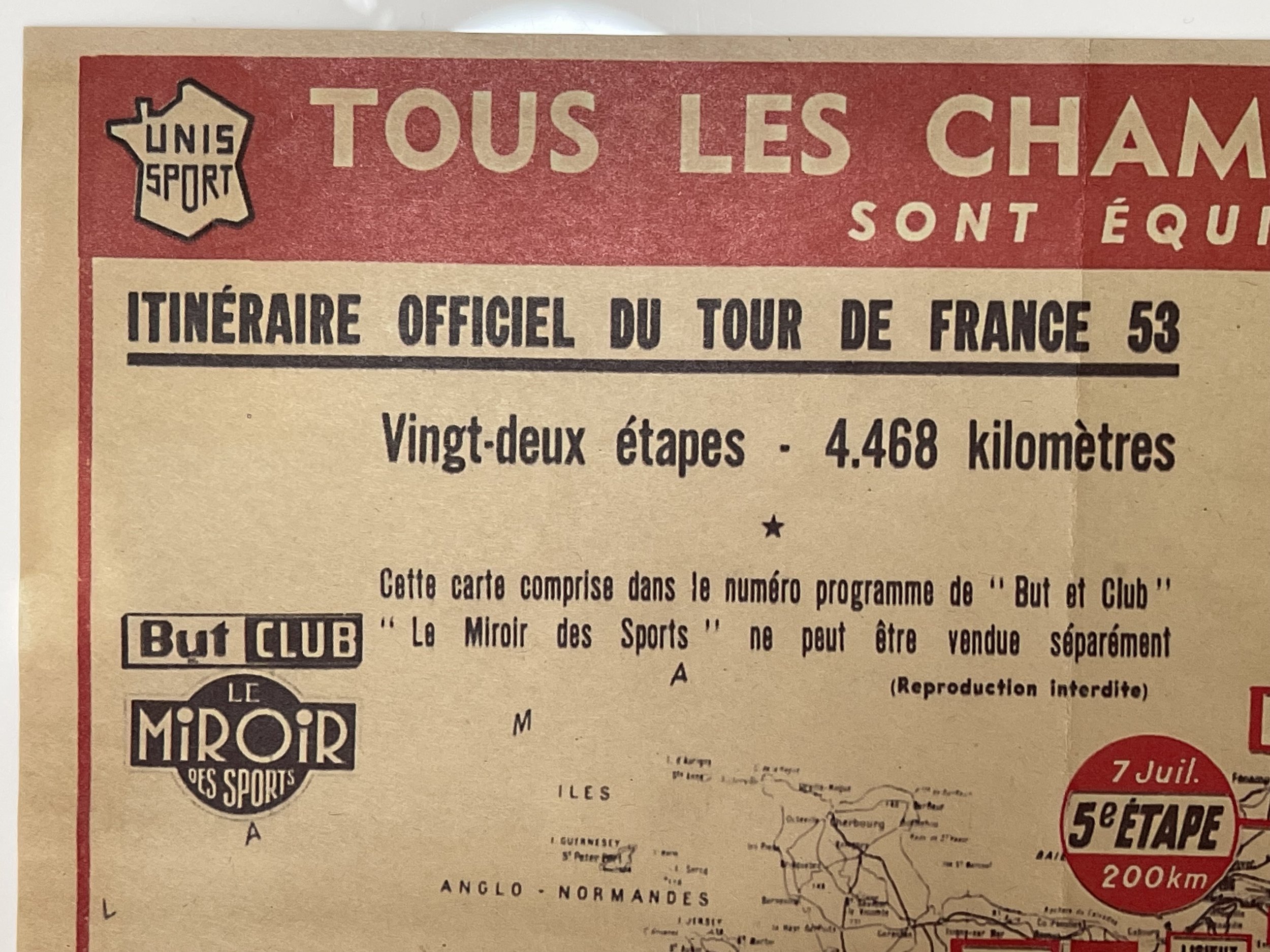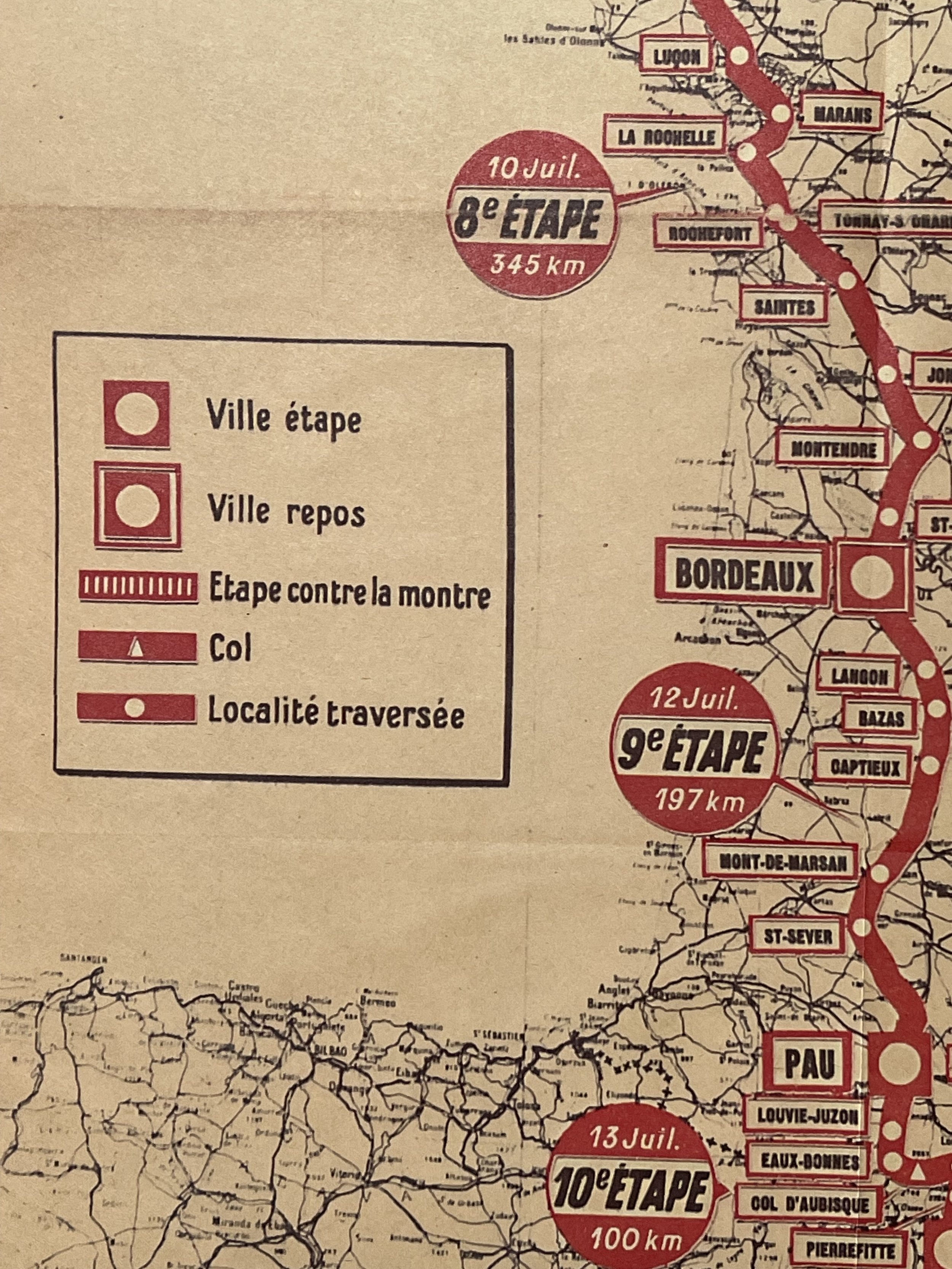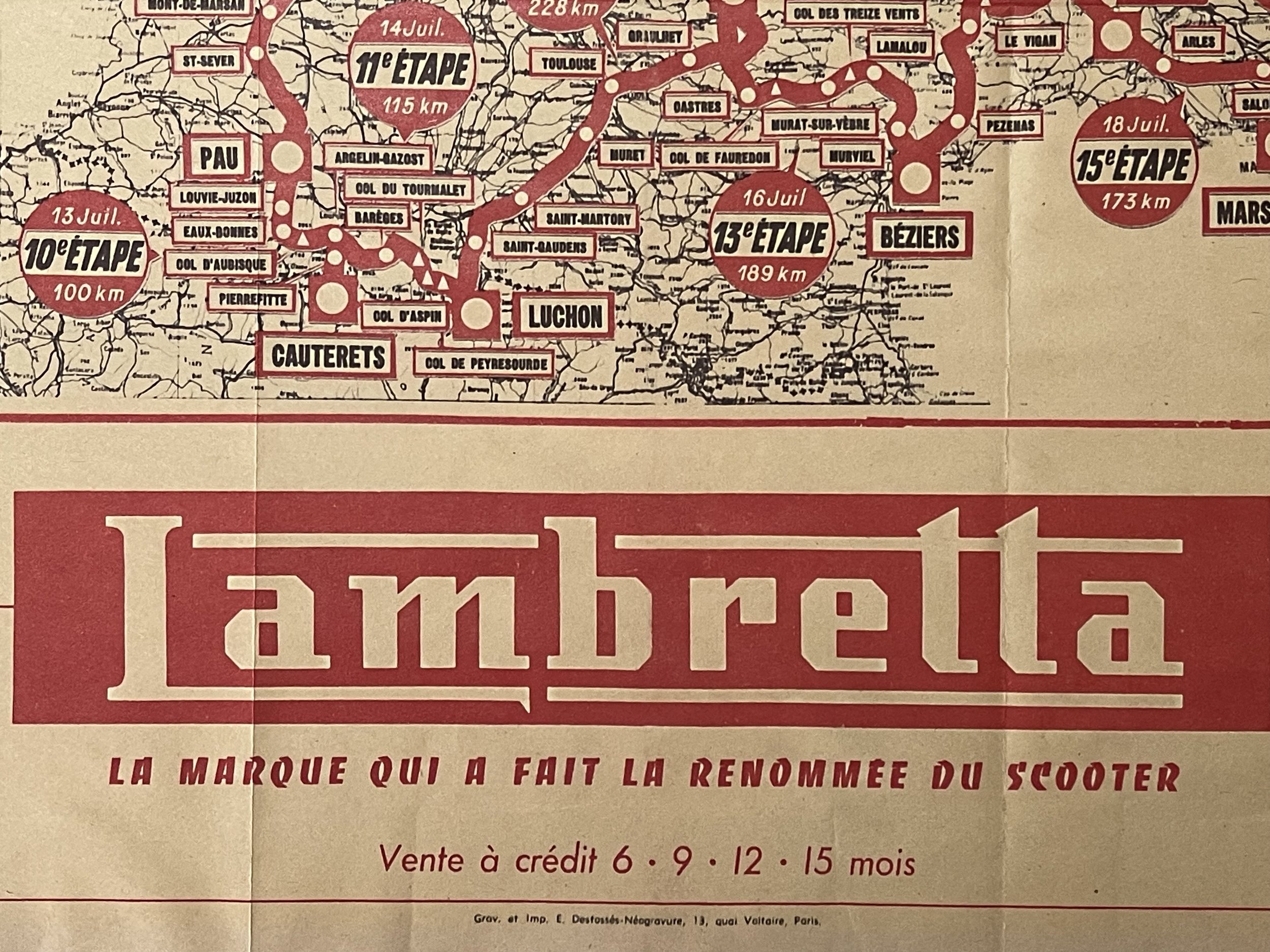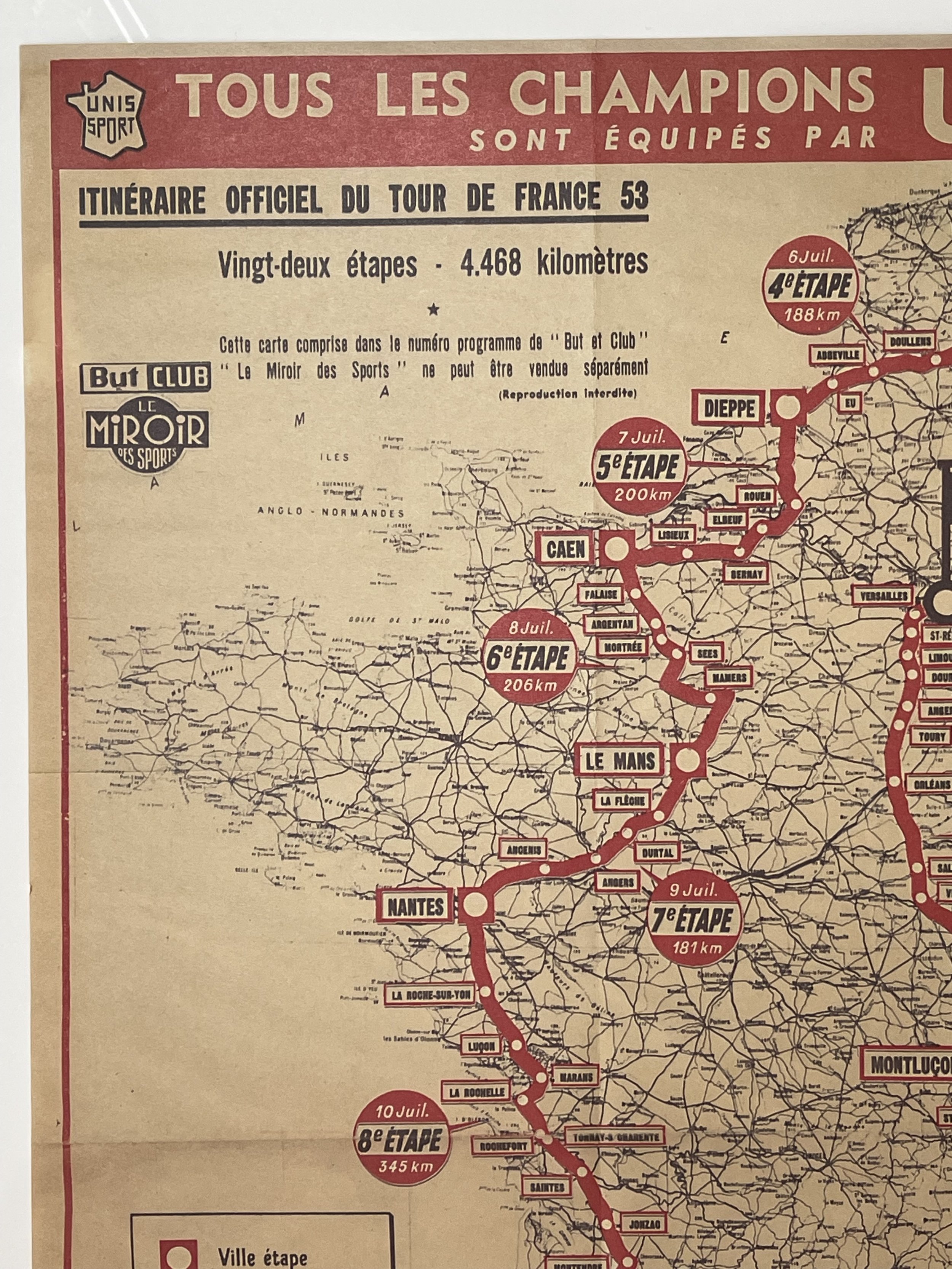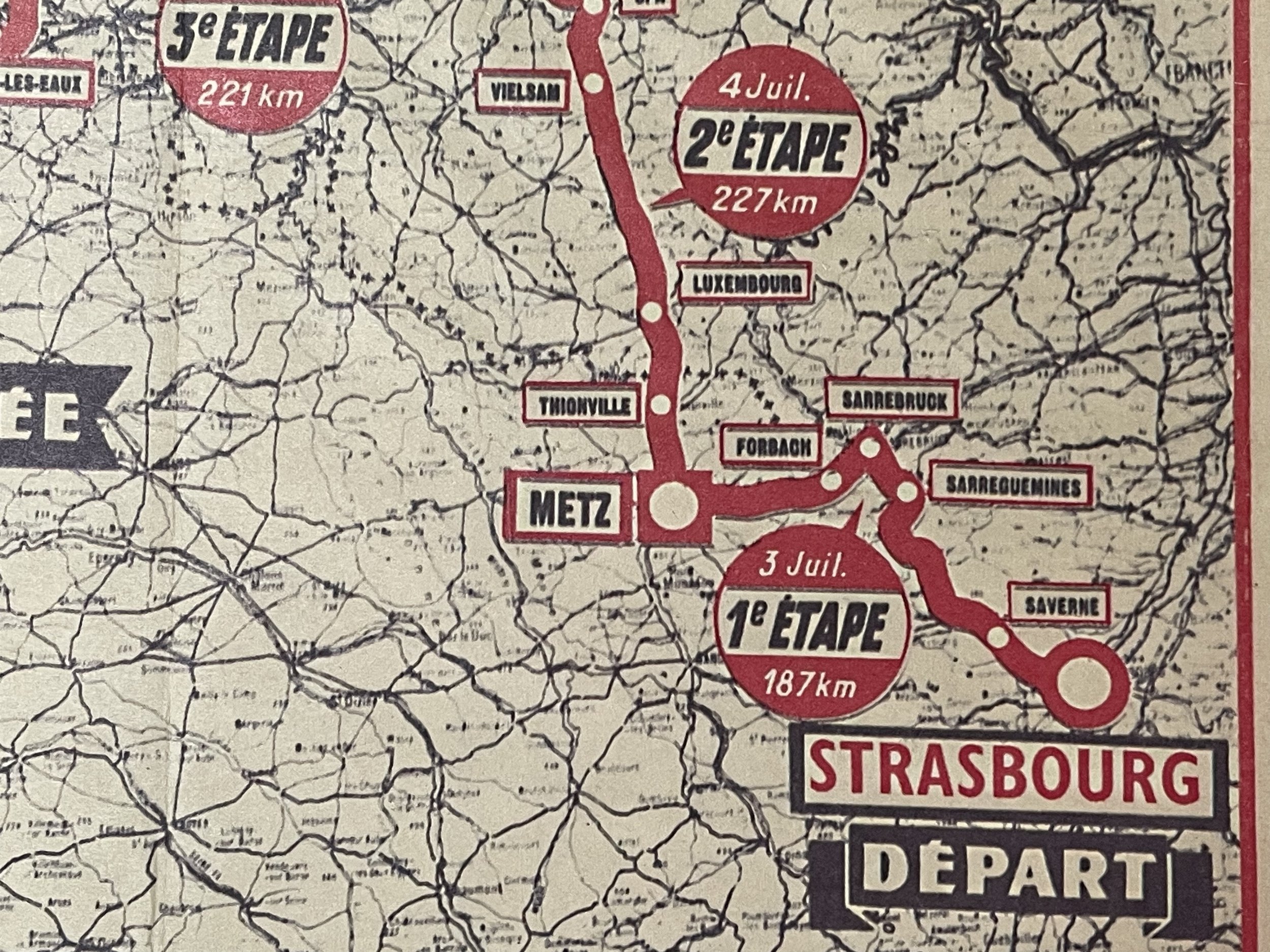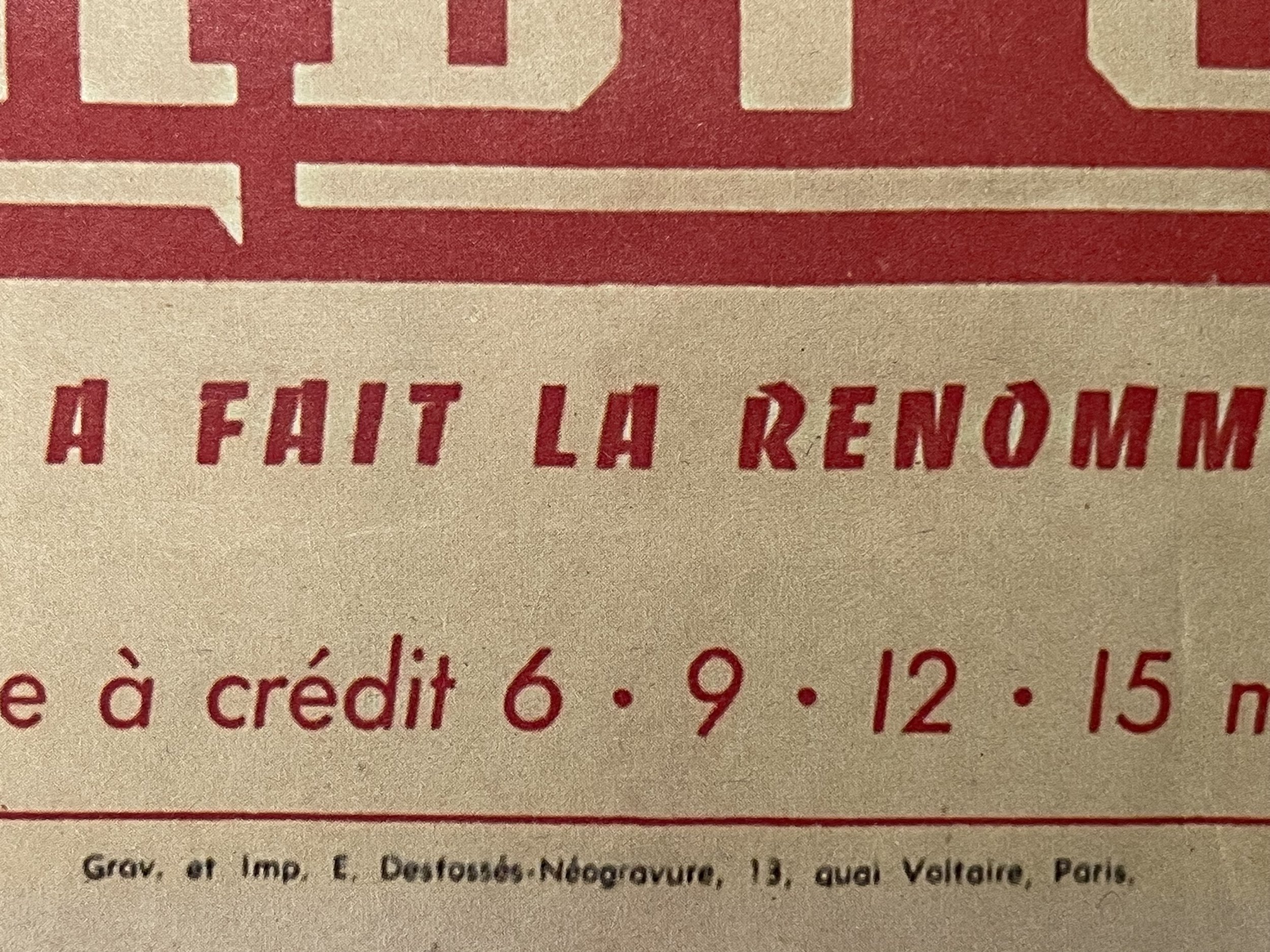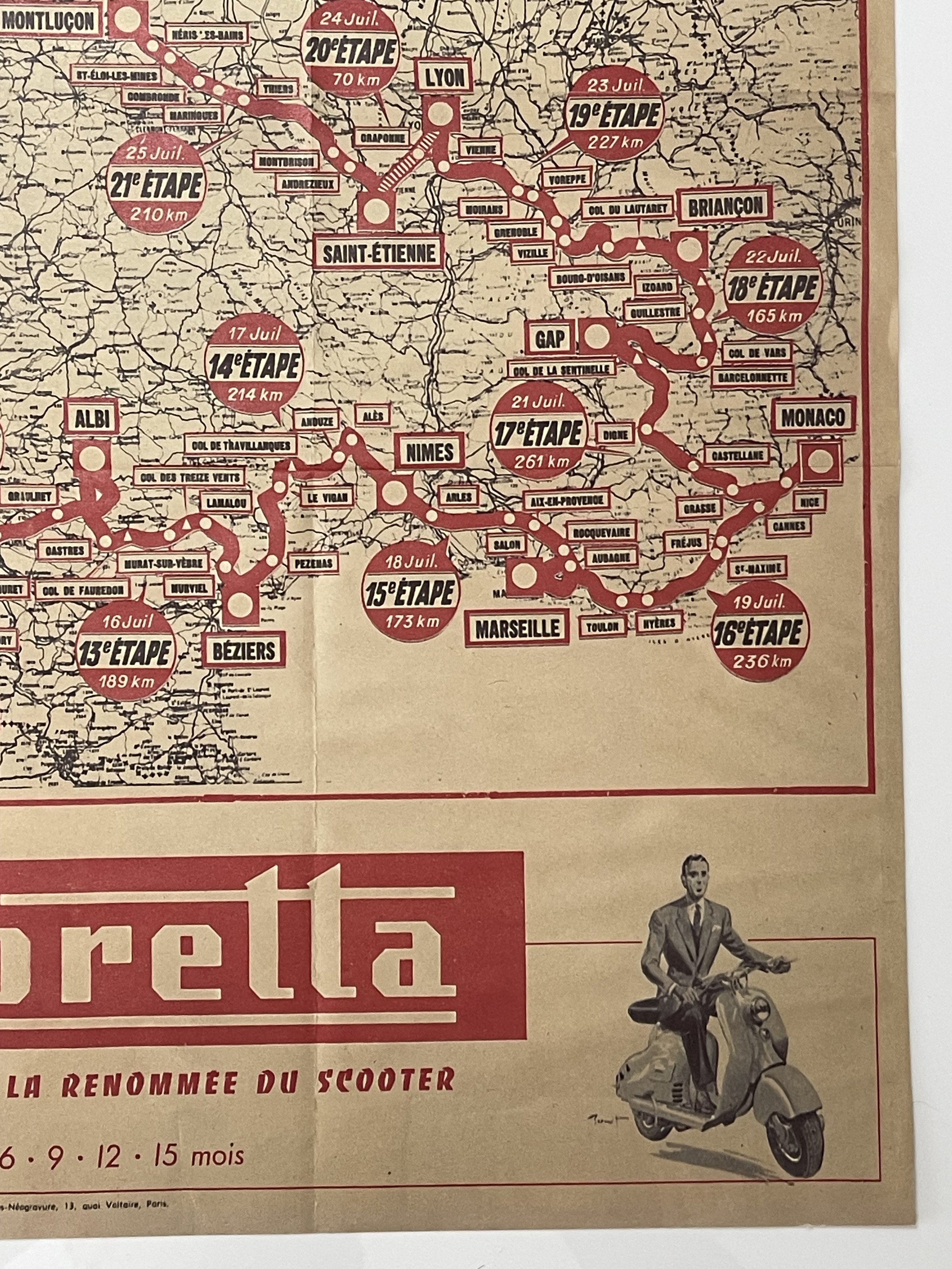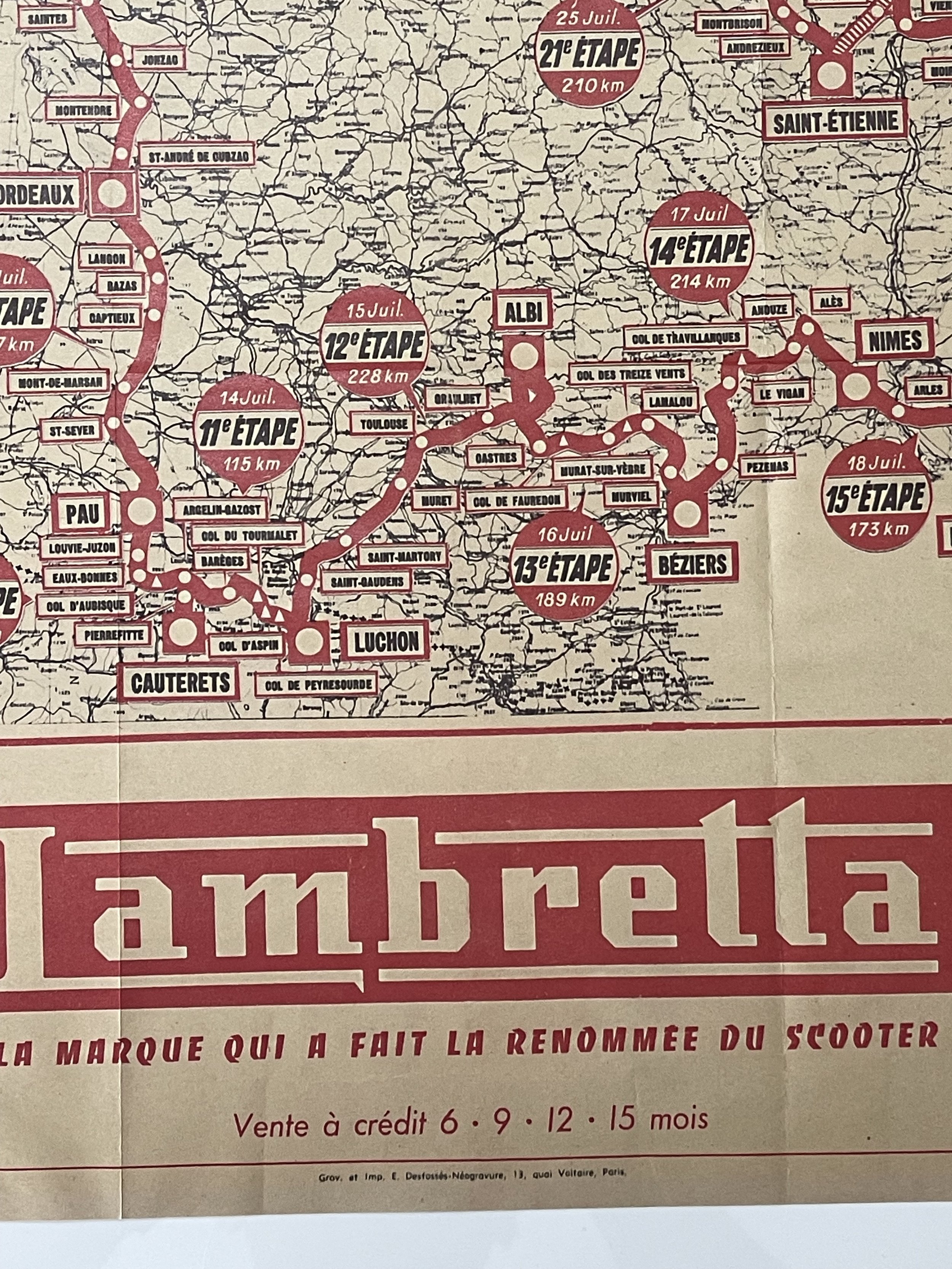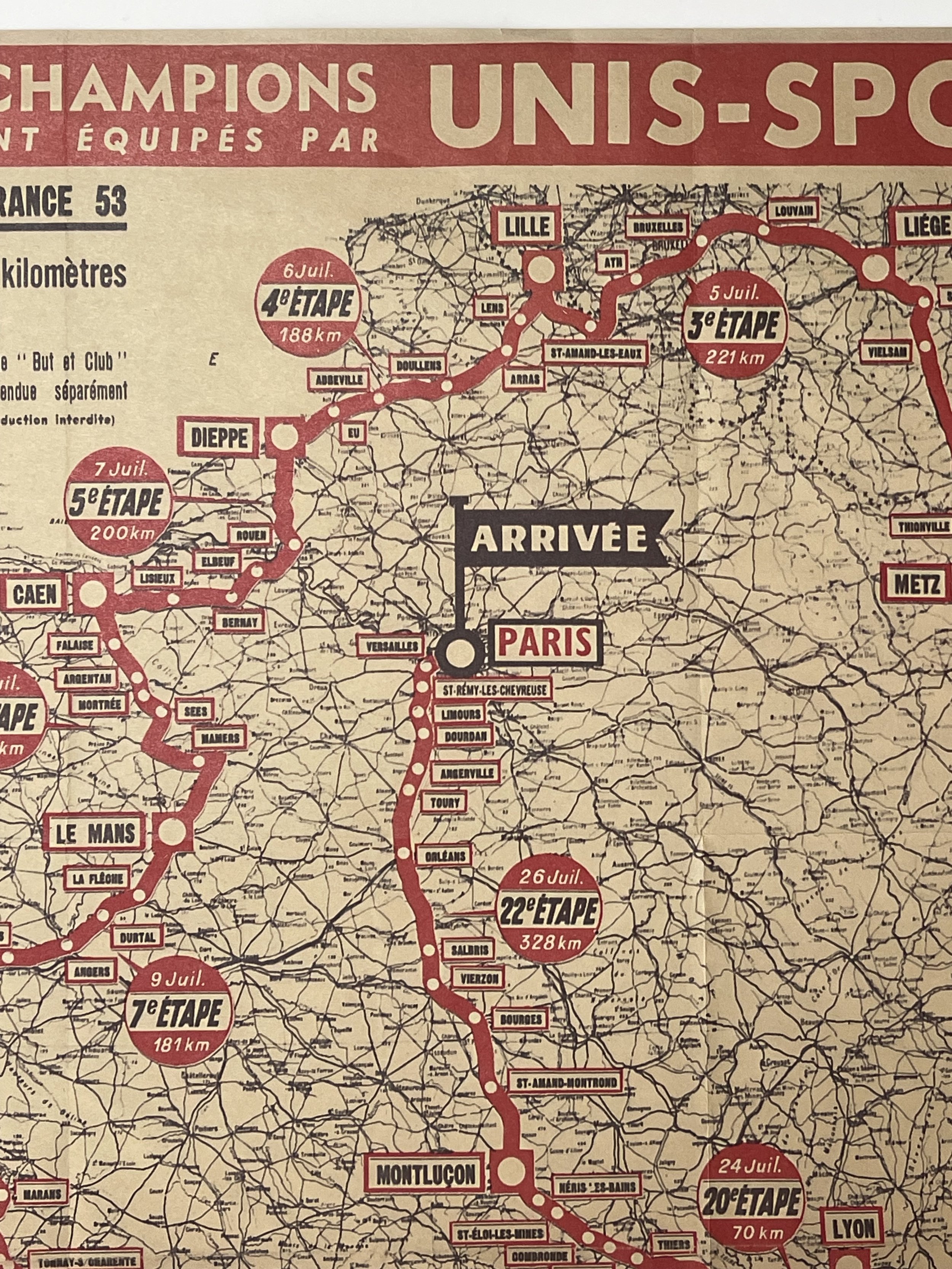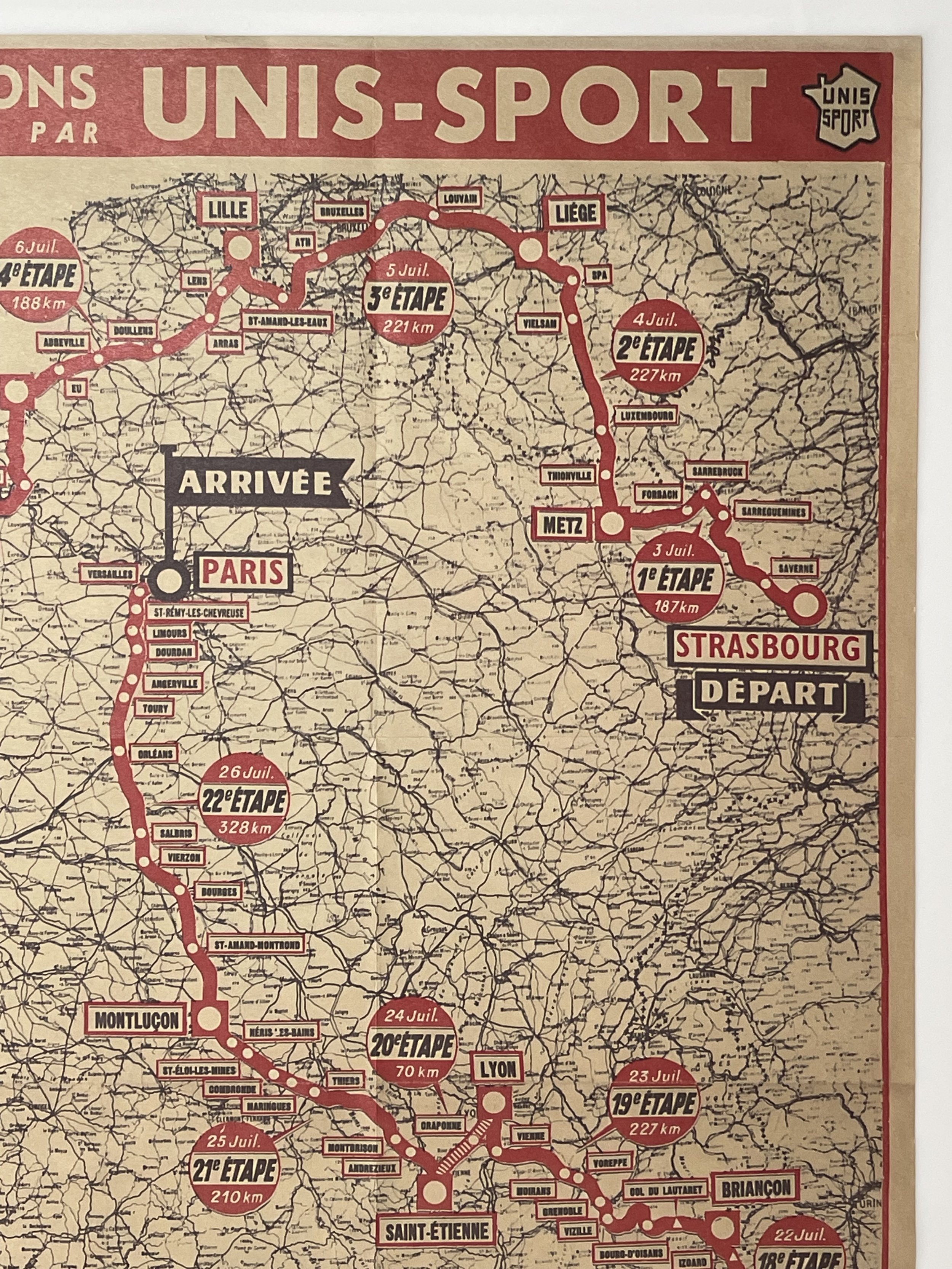Tour De France / Lambretta Map Vintage Cycling Print - TDF 39.20 - 1953 - RARE
Original TOUR DE FRANCE poster 1953. - RARE
Rare original and collectible Tour De France / Lambretta Map Vintage Cycling Print - TDF 39.20 - 1953. Very thin poster so the majority were damaged and discarded. This is a rare early survivor of the period in exceptional condition. Main Sponsors - Unisport and Lambretta.
Printed by Public Limited Company for Periodical Publications (Imprimerie E. Desfossés-Néogravure). French company Paris 7th, 13 quai Voltaire.
In 1965 following the merger of Imprimerie Chaix with the Public Limited Company for Periodical Publications (Imprimerie E. Desfossés-Néogravure), the company became CHAIX-DESFOSSÉS PRINTING HOUSE - NEOGRAVURE.
The Tour De France (TDF), La Grande Boucle, was first organized in 1903 to increase paper sales for the magazine L'Auto. The bicycle race has been traditionally held in the month of July and has run every year except during WWI and WWII.
The Tour de France is an annual men's multiple-stage bicycle race held primarily in France. It is the oldest and most prestigious of the three Grand Tours, which include the Giro d'Italia and the Vuelta a España.
The race was first organised in 1903 to increase sales for the newspaper L'Auto, and has been held annually since, except when stopped for the two World Wars. As the Tour gained prominence and popularity, the race was lengthened and gained more international participation. The Tour is a UCI World Tour event, which means that the teams that compete in the race are mostly UCI World Teams, except for the teams that the organisers invite.
Traditionally, the bulk of the race is held in July. While the route changes each year, the format of the race stays the same, and includes time trials, passage through the mountain chains of the Pyrenees and the Alps, and (except in 2024) a finish on the Champs-Élysées in Paris.
A similar race for women was held under various names between 1984 and 2009. Following criticism by campaigners and the professional women's peloton, a one/two-day race (La Course by Le Tour de France) was held between 2014 and 2021. The first Tour de France Femmes was held in 2022 .
Louison Bobet was the first great French rider of the post-war period and the first rider to win the Tour in three successive years, 1953 (Year of this poster), 1954 and 1955.
Louis "Louison" Bobet 12 March 1925 – 13 March 1983)
Bobet applied for racing licence on leaving the army and by error was issued one for an independent, or semi-professional. He benefited from the right to compete against professionals as well as amateurs. He came second in the Brittany championship and rode the national championship in Paris. There he came up against a veteran professional, Marcel Bidot, who on retirement became Bobet's manager in the national team. Bobet left the field to catch two riders who had broken clear. He dropped one and outsprinted the other to become national champion. He turned fully professional for Stella, a bicycle factory in Nantes.
Tour de France 1953
Bobet is a good climber and time-triallist who rides with authority and intelligence. He is careful with his preparation, careful with his efforts and totally serious. An outstanding rider but has a lack of confidence [morale]. He is extremely nervous, sensitive, worried and susceptible. But with experience he will overcome the problems. A charming friend, happy, often joking and with spirit, but some days he shuts himself off, wrapped in his worries. Jean Bidot, team manager
Bobet rode the 1951 Tour in the blue-white-red of national champion again but cracked in the mountains. Jean Bidot, the manager, sent riders to help him but in the end abandoned him to concentrate on Géminiani, the best placed. Bobet came 20th, although with a stage win. He lost 40 minutes on the last day in the mountains even though the race was taking it easy, Hugo Koblet already being unbeatable. Dick Yates said:
It was a terrible performance for a man of his class, but although he had suffered and suffered, he had not given up the struggle. While this showed character, nobody was prepared to make allowances for it. 'He is just not a stage rider,' they said. 'He'll never win the Tour. No matter how brilliant you may be, if you're not consistent you haven't got a chance.' The sensitive Bobet was stung by this criticism. He had given his all for the Tour but everyone had turned against him. Even Jean Robic, who was not really in Bobet's class, was now more popular and it really hurt.
And then in 1953, after a year without the Tour, Bobet left the field behind on a stage that crossed the Vars. He climbed the Col d'Izoard alone on roads still rutted and strewn with stones and when the gearing on his bicycle forced him to fight to keep it moving. The historian Bill McGann wrote
Stage 18 is etched in the history of the Tour. It was 165km from Gap to Briançon... Bobet knew this was the time to strike. One of Bobet's team-mates, Adolphe Deledda, went clear on the Vars with two other riders. Bobet stayed with the other leading climbers as they ascended the Vars. Spanish rider Jesús Loroño attacked. The alert and very capable Bobet jumped on his wheel and the pair disappeared up the mountain. Bobet was a good descender and dropped Lorono on the way down the Vars. Meanwhile, Deledda, upon being told that Bobet was on his way, eased up and waited for his captain. The two hooked up and took off across the 20km valley floor leading to the Izoard. In doing so they caught and then dispatched Deledda's two original breakaway companions. Bobet and Deledda, knowing the importance of the moment, were men on a mission. Deledda, fulfilling the team contract in both letter and especially in spirit, buried himself towing Bobet to the great mountain. Bobet flew up the Izoard as if he had wings. Bobet had finally arrived as the premier stage racer in the world. As he crested the Izoard there was a very well-known cycling fan by the side of the road. Fausto Coppi with his mistress, Giulia Locatelli (the "woman in white"), was watching the race. As he rode past the great man, Bobet shouted thanks to Coppi for coming.
He won that day by more than five minutes in Briançon, took the yellow jersey as leader of the general classification, then won the time trial and finished the Tour with 14 minutes' lead. He was greeted in Paris by Maurice Garin, winner of the first Tour in 1903, celebrating the Tour's 50th anniversary. He had, however, won a Tour without stars. Kübler was not riding and nor was Coppi, who was standing on the Izoard to watch Bobet pass. Koblet was riding badly and dropped out after a crash. Bartali was too old. Yates' assessment is that "Bobet had won the Tour and won it well but the opposition was hardly top drawer.
Original TOUR DE FRANCE poster 1953. - RARE
Rare original and collectible Tour De France / Lambretta Map Vintage Cycling Print - TDF 39.20 - 1953. Very thin poster so the majority were damaged and discarded. This is a rare early survivor of the period in exceptional condition. Main Sponsors - Unisport and Lambretta.
Printed by Public Limited Company for Periodical Publications (Imprimerie E. Desfossés-Néogravure). French company Paris 7th, 13 quai Voltaire.
In 1965 following the merger of Imprimerie Chaix with the Public Limited Company for Periodical Publications (Imprimerie E. Desfossés-Néogravure), the company became CHAIX-DESFOSSÉS PRINTING HOUSE - NEOGRAVURE.
The Tour De France (TDF), La Grande Boucle, was first organized in 1903 to increase paper sales for the magazine L'Auto. The bicycle race has been traditionally held in the month of July and has run every year except during WWI and WWII.
The Tour de France is an annual men's multiple-stage bicycle race held primarily in France. It is the oldest and most prestigious of the three Grand Tours, which include the Giro d'Italia and the Vuelta a España.
The race was first organised in 1903 to increase sales for the newspaper L'Auto, and has been held annually since, except when stopped for the two World Wars. As the Tour gained prominence and popularity, the race was lengthened and gained more international participation. The Tour is a UCI World Tour event, which means that the teams that compete in the race are mostly UCI World Teams, except for the teams that the organisers invite.
Traditionally, the bulk of the race is held in July. While the route changes each year, the format of the race stays the same, and includes time trials, passage through the mountain chains of the Pyrenees and the Alps, and (except in 2024) a finish on the Champs-Élysées in Paris.
A similar race for women was held under various names between 1984 and 2009. Following criticism by campaigners and the professional women's peloton, a one/two-day race (La Course by Le Tour de France) was held between 2014 and 2021. The first Tour de France Femmes was held in 2022 .
Louison Bobet was the first great French rider of the post-war period and the first rider to win the Tour in three successive years, 1953 (Year of this poster), 1954 and 1955.
Louis "Louison" Bobet 12 March 1925 – 13 March 1983)
Bobet applied for racing licence on leaving the army and by error was issued one for an independent, or semi-professional. He benefited from the right to compete against professionals as well as amateurs. He came second in the Brittany championship and rode the national championship in Paris. There he came up against a veteran professional, Marcel Bidot, who on retirement became Bobet's manager in the national team. Bobet left the field to catch two riders who had broken clear. He dropped one and outsprinted the other to become national champion. He turned fully professional for Stella, a bicycle factory in Nantes.
Tour de France 1953
Bobet is a good climber and time-triallist who rides with authority and intelligence. He is careful with his preparation, careful with his efforts and totally serious. An outstanding rider but has a lack of confidence [morale]. He is extremely nervous, sensitive, worried and susceptible. But with experience he will overcome the problems. A charming friend, happy, often joking and with spirit, but some days he shuts himself off, wrapped in his worries. Jean Bidot, team manager
Bobet rode the 1951 Tour in the blue-white-red of national champion again but cracked in the mountains. Jean Bidot, the manager, sent riders to help him but in the end abandoned him to concentrate on Géminiani, the best placed. Bobet came 20th, although with a stage win. He lost 40 minutes on the last day in the mountains even though the race was taking it easy, Hugo Koblet already being unbeatable. Dick Yates said:
It was a terrible performance for a man of his class, but although he had suffered and suffered, he had not given up the struggle. While this showed character, nobody was prepared to make allowances for it. 'He is just not a stage rider,' they said. 'He'll never win the Tour. No matter how brilliant you may be, if you're not consistent you haven't got a chance.' The sensitive Bobet was stung by this criticism. He had given his all for the Tour but everyone had turned against him. Even Jean Robic, who was not really in Bobet's class, was now more popular and it really hurt.
And then in 1953, after a year without the Tour, Bobet left the field behind on a stage that crossed the Vars. He climbed the Col d'Izoard alone on roads still rutted and strewn with stones and when the gearing on his bicycle forced him to fight to keep it moving. The historian Bill McGann wrote
Stage 18 is etched in the history of the Tour. It was 165km from Gap to Briançon... Bobet knew this was the time to strike. One of Bobet's team-mates, Adolphe Deledda, went clear on the Vars with two other riders. Bobet stayed with the other leading climbers as they ascended the Vars. Spanish rider Jesús Loroño attacked. The alert and very capable Bobet jumped on his wheel and the pair disappeared up the mountain. Bobet was a good descender and dropped Lorono on the way down the Vars. Meanwhile, Deledda, upon being told that Bobet was on his way, eased up and waited for his captain. The two hooked up and took off across the 20km valley floor leading to the Izoard. In doing so they caught and then dispatched Deledda's two original breakaway companions. Bobet and Deledda, knowing the importance of the moment, were men on a mission. Deledda, fulfilling the team contract in both letter and especially in spirit, buried himself towing Bobet to the great mountain. Bobet flew up the Izoard as if he had wings. Bobet had finally arrived as the premier stage racer in the world. As he crested the Izoard there was a very well-known cycling fan by the side of the road. Fausto Coppi with his mistress, Giulia Locatelli (the "woman in white"), was watching the race. As he rode past the great man, Bobet shouted thanks to Coppi for coming.
He won that day by more than five minutes in Briançon, took the yellow jersey as leader of the general classification, then won the time trial and finished the Tour with 14 minutes' lead. He was greeted in Paris by Maurice Garin, winner of the first Tour in 1903, celebrating the Tour's 50th anniversary. He had, however, won a Tour without stars. Kübler was not riding and nor was Coppi, who was standing on the Izoard to watch Bobet pass. Koblet was riding badly and dropped out after a crash. Bartali was too old. Yates' assessment is that "Bobet had won the Tour and won it well but the opposition was hardly top drawer.
Original TOUR DE FRANCE poster 1953. - RARE
Rare original and collectible Tour De France / Lambretta Map Vintage Cycling Print - TDF 39.20 - 1953. Very thin poster so the majority were damaged and discarded. This is a rare early survivor of the period in exceptional condition. Main Sponsors - Unisport and Lambretta.
Printed by Public Limited Company for Periodical Publications (Imprimerie E. Desfossés-Néogravure). French company Paris 7th, 13 quai Voltaire.
In 1965 following the merger of Imprimerie Chaix with the Public Limited Company for Periodical Publications (Imprimerie E. Desfossés-Néogravure), the company became CHAIX-DESFOSSÉS PRINTING HOUSE - NEOGRAVURE.
The Tour De France (TDF), La Grande Boucle, was first organized in 1903 to increase paper sales for the magazine L'Auto. The bicycle race has been traditionally held in the month of July and has run every year except during WWI and WWII.
The Tour de France is an annual men's multiple-stage bicycle race held primarily in France. It is the oldest and most prestigious of the three Grand Tours, which include the Giro d'Italia and the Vuelta a España.
The race was first organised in 1903 to increase sales for the newspaper L'Auto, and has been held annually since, except when stopped for the two World Wars. As the Tour gained prominence and popularity, the race was lengthened and gained more international participation. The Tour is a UCI World Tour event, which means that the teams that compete in the race are mostly UCI World Teams, except for the teams that the organisers invite.
Traditionally, the bulk of the race is held in July. While the route changes each year, the format of the race stays the same, and includes time trials, passage through the mountain chains of the Pyrenees and the Alps, and (except in 2024) a finish on the Champs-Élysées in Paris.
A similar race for women was held under various names between 1984 and 2009. Following criticism by campaigners and the professional women's peloton, a one/two-day race (La Course by Le Tour de France) was held between 2014 and 2021. The first Tour de France Femmes was held in 2022 .
Louison Bobet was the first great French rider of the post-war period and the first rider to win the Tour in three successive years, 1953 (Year of this poster), 1954 and 1955.
Louis "Louison" Bobet 12 March 1925 – 13 March 1983)
Bobet applied for racing licence on leaving the army and by error was issued one for an independent, or semi-professional. He benefited from the right to compete against professionals as well as amateurs. He came second in the Brittany championship and rode the national championship in Paris. There he came up against a veteran professional, Marcel Bidot, who on retirement became Bobet's manager in the national team. Bobet left the field to catch two riders who had broken clear. He dropped one and outsprinted the other to become national champion. He turned fully professional for Stella, a bicycle factory in Nantes.
Tour de France 1953
Bobet is a good climber and time-triallist who rides with authority and intelligence. He is careful with his preparation, careful with his efforts and totally serious. An outstanding rider but has a lack of confidence [morale]. He is extremely nervous, sensitive, worried and susceptible. But with experience he will overcome the problems. A charming friend, happy, often joking and with spirit, but some days he shuts himself off, wrapped in his worries. Jean Bidot, team manager
Bobet rode the 1951 Tour in the blue-white-red of national champion again but cracked in the mountains. Jean Bidot, the manager, sent riders to help him but in the end abandoned him to concentrate on Géminiani, the best placed. Bobet came 20th, although with a stage win. He lost 40 minutes on the last day in the mountains even though the race was taking it easy, Hugo Koblet already being unbeatable. Dick Yates said:
It was a terrible performance for a man of his class, but although he had suffered and suffered, he had not given up the struggle. While this showed character, nobody was prepared to make allowances for it. 'He is just not a stage rider,' they said. 'He'll never win the Tour. No matter how brilliant you may be, if you're not consistent you haven't got a chance.' The sensitive Bobet was stung by this criticism. He had given his all for the Tour but everyone had turned against him. Even Jean Robic, who was not really in Bobet's class, was now more popular and it really hurt.
And then in 1953, after a year without the Tour, Bobet left the field behind on a stage that crossed the Vars. He climbed the Col d'Izoard alone on roads still rutted and strewn with stones and when the gearing on his bicycle forced him to fight to keep it moving. The historian Bill McGann wrote
Stage 18 is etched in the history of the Tour. It was 165km from Gap to Briançon... Bobet knew this was the time to strike. One of Bobet's team-mates, Adolphe Deledda, went clear on the Vars with two other riders. Bobet stayed with the other leading climbers as they ascended the Vars. Spanish rider Jesús Loroño attacked. The alert and very capable Bobet jumped on his wheel and the pair disappeared up the mountain. Bobet was a good descender and dropped Lorono on the way down the Vars. Meanwhile, Deledda, upon being told that Bobet was on his way, eased up and waited for his captain. The two hooked up and took off across the 20km valley floor leading to the Izoard. In doing so they caught and then dispatched Deledda's two original breakaway companions. Bobet and Deledda, knowing the importance of the moment, were men on a mission. Deledda, fulfilling the team contract in both letter and especially in spirit, buried himself towing Bobet to the great mountain. Bobet flew up the Izoard as if he had wings. Bobet had finally arrived as the premier stage racer in the world. As he crested the Izoard there was a very well-known cycling fan by the side of the road. Fausto Coppi with his mistress, Giulia Locatelli (the "woman in white"), was watching the race. As he rode past the great man, Bobet shouted thanks to Coppi for coming.
He won that day by more than five minutes in Briançon, took the yellow jersey as leader of the general classification, then won the time trial and finished the Tour with 14 minutes' lead. He was greeted in Paris by Maurice Garin, winner of the first Tour in 1903, celebrating the Tour's 50th anniversary. He had, however, won a Tour without stars. Kübler was not riding and nor was Coppi, who was standing on the Izoard to watch Bobet pass. Koblet was riding badly and dropped out after a crash. Bartali was too old. Yates' assessment is that "Bobet had won the Tour and won it well but the opposition was hardly top drawer.
Code : A1067
Cartographer : Cartographer / Engraver / Publisher: Public Limited Company for Periodical Publications (Imprimerie E. Desfossés-Néogravure)
Date : Publication Place / Date - Circa 1953
Size : Sheet size: approx 60 x 47 Cm
Availability : Available
Type - Genuine - Vintage
Grading A+
Where Applicable - Folds as issued. Light box photo shows the folio leaf centre margin hinge ‘glue’, this is not visible otherwise.
Tracked postage, in casement. Please contact me for postal quotation outside of the UK.

